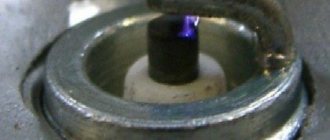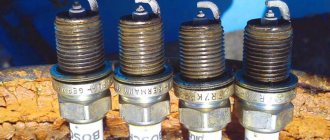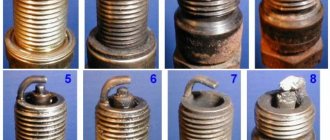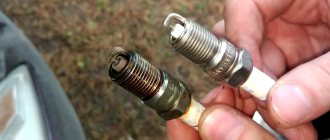Checking and setting the gap - practical advice
In order to correctly measure the distance and, if necessary, clean and align the electrodes without a probe, you need to carefully unscrew the spark plugs from the car. In this case, first, be sure to reset the negative terminal from the battery. Once the spark plugs are out, inspect them for any damage. If a visual inspection shows damage, then they most likely should be replaced, otherwise, even with the correct clearance, problems may arise in their operation.
If there is no damage, we proceed to clean the carbon deposits, if any. You can clean it with various means, with a regular cloth soaked in WD-40 or a cleaning solution. After thorough cleaning, measure the gap. For this, you can also use ordinary household measuring instruments such as a ruler. But it will be difficult to determine the exact size, since we are talking about millimeters, so we recommend taking special probe wrenches in the shape of the letter “L” of various sizes, which are specifically designed for accurately measuring small millimeter distances on car parts.
As for standards and permissible limits, they may differ for different models, but there is a generally accepted classification. So, the lower limit should not be less than 0.4 mm, the upper limit should not be less than 1.3 mm. More specific data depends on the type of engine and ignition system, namely:
- carburetor engine with ignition distributor: min. – 0.5, max. – 0.7 mm.
- carburetor engine with electronic ignition: range from 0.7 to 1 mm.
- injection engine types: recommended spark plug gap is from 0.9 to 1.3 mm.
The difference between spark plug gaps on different types of engines is determined by the power of the electrical circuit. It is known that the weakest voltage is on conventional carburetor engines with a distributor; the spark is relatively weak, so for spark plugs the minimum permissible gap between the electrodes is set. Whereas in injection engines the power of the circuit is quite high, so the gap increases depending on the power of the motor, but it should not be less than 0.9 mm and no more than 1.3 mm.
We recommend: The principle of operation of a car generator, its structure and connection diagram
Modern technologies
What I want to say in conclusion, many will think “come on,” why should I bother with some distance between the electrodes! Guys, very wrong thoughts.
Firstly, you can save on fuel, studies show up to 5 – 7%
Secondly, smooth engine operation is the key to driving safety.
Third, the correct gap between the spark plugs increases their service life; there is no chance that the insulator will break through (with an increased distance).
I would like to note that some companies, on the contrary, increase the number of contacts (electrodes), strengthen the coils and the ignition system, all so that the mixture is ignited better.
There are also more modern technologies now, which I think will soon replace them - such as plasma candles.
They have no electrodes at all, and the fuel is ignited by a beam of plasma that is generated by electricity. As they write, the production is now undergoing tests and they say that the combustion efficiency of the fuel mixture is increasing, which means a little more power, a little more economy and environmental friendliness of the engine.
Effect of gap on ignition
To understand how this factor affects the efficiency of a gasoline engine, you need to briefly consider the operation of the ignition system. The algorithm for converting fuel energy into mechanical work looks like this:
- Having released the exhaust gases through the valve into the cylinder head, the piston moves downwards. When it reaches the lowest point, the second valve opens, from where the air-fuel mixture enters the cylinder.
- The piston rises to the combustion chamber and compresses this aerosol several times.
- At the moment when the piston crown is at top dead center, a high-voltage pulse is applied to the spark plug electrodes. A spark jumps between them, igniting the compressed mixture of fuel and air.
- Burning at a certain speed, the fuel releases energy that pushes the piston down. Mechanical work is performed.
- The last stroke is the release of combustion products into the exhaust system, after which the cycle repeats.
A high voltage pulse (over 20 kilovolts) is generated by a coil based on a signal from the controller. Its winding is designed to generate a spark of a certain force, sufficient for high-quality ignition of a portion of the fuel mixture. If the gap in the spark plugs is too large or small, the combustion process will be disrupted.
Large gap between electrodes
A gap greater than 1.3 mm is considered abnormally large. What happens if the electrodes are extended to this extent:
Spark plug heat number
- the coil power is not enough to spark an increased distance with each compression stroke, skipping cycles will appear;
- the operation of the power unit will be unstable and vibration will appear;
- one part of the unburnt gasoline will flow down the cylinder walls and enter the crankcase, the second will be thrown into the exhaust tract;
- fuel consumption will increase;
- Carbon deposits quickly form on the walls of the combustion chamber, the piston bottom and the working elements of the spark plugs.
As a result of the above processes, the engine will not deliver full power, and the cylinder-piston group will wear out faster in the long run. Too large a gap affects the quality of fuel combustion, you will feel this while driving: car acceleration will be sluggish, and engine vibration will be increased. Due to skipping cycles, problems with cold starting will appear - the engine will start after several attempts.
We recommend: Thermostat: principle of operation, types, design, photo, video.
Interelectrode distance too small
A distance between spark plug contacts of less than 0.6 mm is considered unacceptably small. True, skipping work cycles will not be observed, but another problem will arise - too weak ignition. A short spark that breaks through a small gap from one electrode to another is not capable of properly igniting the air-fuel mixture, which occupies the entire volume of the chamber.
Due to the reduced burning rate, the air-gasoline aerosol will not have time to burn out entirely before the stroke of the piston begins, and then the exhaust gases are released. As a result, the consequences described above occur - a drop in the power of the power unit, increased fuel consumption, soot in the exhaust and carbon deposits inside the cylinders.
Incorrect adjustment of the spark plug gap is often aggravated by other factors: wear of the piston group, problems in the fuel supply system, broken insulation of high-voltage wires, and so on. Then the problem of adjusting the gaps recedes into the background and often falls out of sight of the car enthusiast.
Ignition operation in the combustion chamber
Spark plugs are the very last element in igniting a car. They are constantly in direct contact with a mixture of gasoline and air. It is the candles that ignite the combustible mixture. And ignition can be effective, as it should be according to technical regulations and engineers’ ideas, or with low efficiency due to the influence of certain factors.
After the fuel-air mixture enters the engine cylinder, the piston will go up. This way the mixture is compressed. At the moment when the piston reaches its peak or dead point, the Hall sensor or ECU gives a pulse or command. As a result, the mixture ignites. The spark plug is responsible for ignition - an electric spark jumps between its two electrodes, which provokes the combustion of the fuel mixture.
But this combustion may not happen. This is not necessarily due to any problems with the ignition system. The gap is simply set incorrectly. Thus, misfires may occur, which significantly reduces engine efficiency. Sometimes the engine may not start at all.
Reducing and increasing the gap
When the engine is running, spark plugs also perform their functions. Accordingly, it is possible for them to decrease or increase the interelectrode length. Different results are possible regarding the nature of the gap.
If the gap between the spark plug electrodes is reduced, the following consequences appear:
- The power of the spark increases, but it becomes short, which is reflected in the inability to influence the combustible mixture. As a result, a flood of spark plugs occurs, which affects such a phenomenon as “the car begins to stall.”
- The likelihood of an electric arc forming at high speeds increases. This is due to the fact that a spark obtained at a small electrode distance does not have time to explode. Therefore, there is a continuous flow, affecting the operation of the motor and coil, in which a short circuit may occur. Such moments entail the replacement of many parts.
The results of a small gap of electrode elements imply repair of the engine and its components.
If the electrode gap increases, the following problems arise:
The gap size on the spark plugs, its measurement and adjustment
- Insulator breakdown;
- Failure of the ignition coil;
- Impaired self-cleaning of the spark plug, which results in loss of spark.
As a result of the fact that the distance becomes larger, the spark does not fulfill its role and this affects the engine's priming. Therefore, you can notice that the car “troubles” and often stalls.
Of course, when operating the electrodes, you can observe a natural increase in the gap due to burning. Given these circumstances, it is necessary to regularly check the spark plugs.
Spark plug gap
Review (rating) of recommended candles for HBO
Based on numerous reviews from drivers, we will consider some of the most popular models of spark plugs for working on a propane-butane mixture and methane with brief characteristics.
The most common (due to cheapness) Brisk Silver spark plugs for gas (Brisk Silver LPG/CNG - Czech Republic) have a silver central electrode of small diameter. Their price varies from 120-300 rubles per piece:
| Candle marking | Gap, mm | Seal | Replacement interval, km | Key size, mm | Thread length, mm | Thread size | Tightening torque, N*m |
| 1BR12S | 0.55 | w | max. 20.000 | 16 | 15 | M 12×1.25 | 15-20 |
| AR12YS | 0.7 | w | max. 30.000 | 16 | 19 | M 10×1.00 | 10-15 |
| AR14YS | 0.7 | w | max. 30.000 | 16 | 19 | M 10×1.00 | 10-15 |
| BR14YS | 0.7 | w | max. 30.000 | 16 | 19 | M 12×1.25 | 15-20 |
| BR14YS-9 | 0.9 | w | max. 30.000 | 16 | 19 | M 12×1.25 | 15-20 |
| DOR15YS | 0.7 | w | max. 30.000 | 16 | 21 | M 14×1.25 | 20-30 |
| DOR15YS-1 | 1 | w | max. 30.000 | 16 | 21 | M 14×1.25 | 20-30 |
| DR14YS | 0.7 | w | max. 30.000 | 16 | 19 | M 14×1.25 | 20-30 |
| DR14YS-9 | 0.9 | w | max. 30.000 | 16 | 19 | M 14×1.25 | 20-30 |
| DR15YS | 0.7 | w | max. 30.000 | 16 | 19 | M 14×1.25 | 20-30 |
| DR15YS-9 | 0.9 | w | max. 30.000 | 16 | 19 | M 14×1.25 | 20-30 |
| DR17YS | 0.7 | w | max. 30.000 | 16 | 19 | M 14×1.25 | 20-30 |
| DR17YS-9 | 0.9 | w | max. 30.000 | 16 | 19 | M 14×1.25 | 20-30 |
| ER15YS-9 | 0.9 | w | max. 30.000 | 16 | 26,5 | M 14×1.25 | 20-30 |
| GR14YS | 0.7 | K | max. 30.000 | 16 | 17,5 | M 14×1.25 | 10-20 |
| GR15YS | 0.7 | K | max. 30.000 | 16 | 17,5 | M 14×1.25 | 10-20 |
| GR15YS-9 | 0.9 | K | max. 30.000 | 16 | 17,5 | M 14×1.25 | 10-20 |
| GR17YS | 0.8 | K | max. 30.000 | 16 | 17,5 | M 14×1.25 | 10-20 |
| LR12YS | 0.7 | w | max. 30.000 | 21 | 19 | M 14×1.25 | 20-30 |
| LR14YS | 0.7 | w | max. 30.000 | 21 | 19 | M 14×1.25 | 20-30 |
| LR15YS | 0.7 | w | max. 30.000 | 21 | 19 | M 14×1.25 | 20-30 |
| LR15YS-9 | 0.9 | w | max. 30.000 | 21 | 19 | M 14×1.25 | 20-30 |
| LR17YS | 0.7 | w | max. 30.000 | 21 | 19 | M 14×1.25 | 20-30 |
| LR17YS-9 | 0.9 | w | max. 30.000 | 21 | 19 | M 14×1.25 | 20-30 |
| LOR15YS | 0.7 | w | max. 30.000 | 21 | 21 | M 14×1.25 | 20-30 |
| MR14LS | 0.7 | w | max. 30.000 | 14 | 26,5 | M 12×1.25 | 15-20 |
| NR14S | 0.55 | w | max. 30.000 | 21 | 12,7 | M 14×1.25 | 20-30 |
| NR15S | 0.55 | w | max. 30.000 | 21 | 12,7 | M 14×1.25 | 20-30 |
| RR15YS | 0.7 | K | max. 30.000 | 16 | 25 | M 14×1.25 | 10-20 |
| RR15YS-9 | 0.9 | K | max. 30.000 | 16 | 25 | M 14×1.25 | 10-20 |
| RR15YS-1 | 1 | K | max. 30.000 | 16 | 25 | M 14×1.25 | 10-20 |
| RR17YS-1 | 1 | K | max. 30.000 | 16 | 25 | M 14×1.25 | 10-20 |
| K-cone seal |
| Ш-sealing with washer |
Affordable candles from Bosch (Bosch-Germany) also have excellent recommendations and are marked BGB in the catalog. Well suited to internal combustion engines with 4th generation LPG. Cost 180-220 rubles. for one unit:
| Spark plug marking/electrode material | Gap, mm | Seal | Replacement interval, km | Key size, mm | Thread length, mm | Thread size | Tightening torque, N*m |
| FR7DC/chrome-nickel with copper rod | 0,9 | w | max. 30.000 | 16 | 19 | M 14×1.25 | 30 |
| YR6DES/silver | 0,7 | w | max. 40.000 | 16 | 19 | M 12×1.25 | 25 |
| WR7DP/platinum | 0,8 | w | max. 60.000 | 21 | 19 | M 14×1.25 | 30 |
Denso candles of the TT series (Denso-Japan) can be considered the best in terms of price/quality ratio. The central and side electrodes are made of nickel alloy, which ensures smooth engine operation, fuel economy and reduced exhaust emissions. Price for one piece is 150-180 rubles. The line also includes iridium spark plugs for gas equipment, which are not so affordable in price (550 rubles per 1 piece), but have an increased service life, more stable spark formation and resistance to low temperatures:
| Spark plug marking/electrode material | Gap, mm | Seal | Replacement interval, km | Key size, mm | Thread length, mm | Thread size | Tightening torque, N*m |
| W22TT/nickel | 0,8 | w | max. 60.000 | 16 | 17,5 | M 14×1.25 | 20-25 |
| K20TT/nickel | 1,1 | w | max. 60.000 | 16 | 19 | M 14×1.25 | 20-25 |
| IT20TT/iridium | 0,8 | w | max. 120.000 | 16 | 17,5 | M 14×1.25 | 20-25 |
| IW20TT/iridium | 0,8 | w | max. 120.000 | 21 | 19 | M 14×1.25 | 20-25 |
| IK20TT/iridium | 1,1 | w | max. 120.000 | 16 | 19 | M 14×1.25 | 20-25 |
| VW22/iridium | 0,8 | w | max. 120.000 | 21 | 19 | M 14×1.25 | 20-25 |
An excellent choice for most cars - NGK LPG LaserLine No. 1-8 spark plugs with a central iridium electrode, platinum soldering on the side electrode and a special insulator design ensure optimal operation of the internal combustion engine in any operating mode. There is one drawback - the price for 1 piece is on average 700 rubles:
| Candle marking | Gap, mm | Seal | Replacement interval, km | Key size, mm | Thread length, mm | Thread size | Tightening torque, N*m |
| LPG 1 | 0,8 | Sh | max. 60.000 | 16 | 19 | M 14×1.25 | 25-30 |
| LPG 2 | 0,8 | Sh | max. 60.000 | 21 | 19 | M 14×1.25 | 25-30 |
| LPG 3 | 0,8 | Sh | max. 60.000 | 16 | 19 | M 14×1.25 | 25-30 |
| LPG 4 | 0,8 | To | max. 60.000 | 16 | 25,5 | M 14×1.25 | 10-20 |
| LPG 5 | 0,8 | w | max. 60.000 | 16 | 17,5 | M 14×1.25 | 25-30 |
| LPG 6 | 0,8 | w | max. 60.000 | 16 | 19 | M 14×1.25 | 25-30 |
| LPG 7 | 0,8 | w | max. 60.000 | 16 | 26,5 | M 14×1.25 | 25-30 |
| LPG 8 | 0,8 | w | max. 60.000 | 16 | 19 | M 12×1.25 | 15-20 |
A more detailed selection of spark plugs for a specific car can be made by downloading the electronic catalog of the manufacturer of interest using the links below.
- We select spark plugs denso, ngk, bosh, beru, champion by car make
Source
What is iridium?
Iridium is a very hard metallic element. It is believed that this material was formed on our planet due to meteor showers many years ago. It is precisely because this metal has high hardness that it is used as an electrode material for the manufacture of spark plugs
Its second important property is melting at a temperature of about 2,800°C.
Very reliable, have a long service life and are resistant to temperature changes - all these are iridium spark plugs. Reviews from owners of cars “filled” with this metal confirm this fact on thematic forums.
Since the 80s of the last century, this material began to be actively used as an alloy for igniters in industrial production. Due to its fragility and low electrical conductivity, this metal cannot be used in its pure form. Only in alloys does iridium show its best properties.
Counterfeit detection
The popularity of NLC candles has caused many counterfeit products to appear on the market. Externally, the product is very similar to the branded one, but its quality is much lower. You can distinguish a fake by carefully examining the candles. The following features are important:
- The packaging has even slots and resistant paint, and is glued together efficiently and reliably.
- The thread is knurled and there are no nicks or any irregularities on it. If the item is cut, this indicates that it is fake.
- The original has smooth, indelible, clear markings.
- The ceramics from which the insulator is made are of high quality. Its remains in powder form can be found on the metal part of the case.
- The terminal nut is tightly secured and requires considerable force to unscrew it.
- The electrode is well centered. The sparking end of the insulator is free of any contamination.
A wide selection of NGK spark plugs allows you to choose the optimal model for almost any make of car. The high quality and reasonable price of the products ensures the popularity of the Japanese company's products in the market. Buying candles in trusted stores and carefully checking the purchased product will help you avoid counterfeits.
Choice
The choice of candles today is quite extensive. But we’ll talk about which ones are used for the VAZ 2110 and what can currently be considered the best choice for your car.
Candles differ from each other mainly in the material from which the electrodes are made.
Candle type
Peculiarities
These are classic spark plugs for VAZ, installed by the factory. The operating life is up to 50 thousand kilometers. Some of them are coated with yttrium alloy to increase the reliability of the electrode.
They are characterized by increased resistance to temperature fluctuations and corrosion, which has a positive effect on the service life of the elements. Such elements are capable of operating up to 90 thousand kilometers
The characteristics are in many ways close to platinum candles; today they are considered the most durable and high-quality. Safety margin - about 90-100 thousand kilometers
The service life may increase or decrease depending on the care, conditions of use of the vehicle, and the quality of the fuel being poured.
Platinum candle
Replacement
If cleaning and drying did not give any result, and checking the remaining elements of the ignition circuit did not reveal other sources of problems, then the fault lies with the spark plugs. They need to be replaced.
Replacing an element
To replace spark plugs you will need:
- Spark plug head;
- Ratchet or crank;
- Extension;
- A set of new spark plugs.
Let's get to work.
- Disconnect the high-voltage wires from the spark plugs on your VAZ 2110.
- The ignition elements are unscrewed using the head and knob.
- The first movement when unscrewing can be difficult, therefore it is strongly not recommended to unscrew the spark plugs sharply. You may strip the threads.
- If during dismantling the spark plug gets stuck, screw it back a couple of turns, then carefully unscrew it again.
- Clean the places where the spark plugs are planted from any dirt that has formed, check the condition of the rings.
- Install new spark plugs in place of the old ones. It is necessary to tighten the elements with a certain torque - 31-19 Nm.
- Connect the high-voltage wires and test run the engine.
Removing with a puller
Even if these are new spark plugs, we advise you to first check the gap level so that it complies with the regulated standards.
Replacing spark plugs is quite simple, as is checking the gap. But when choosing between cleaning and replacement, we recommend choosing the second option. The fact is that using any of the above methods for cleaning spark plugs can harm the car. This is especially true for chemically aggressive substances; contact with engine components or engine compartments can lead to quite dire consequences. It's much easier to just change the spark plugs. Moreover, they are not expensive.
Owning a car means regularly replacing many parts. One of these parts are spark plugs, which are responsible for the timely ignition of the air-gasoline mixture. Their performance is assessed by analyzing the gap between the electrodes. It can vary depending on many factors. Therefore, if problems arise in the operation of the engine, the spark plugs are first checked. In this case, the gap between the electrodes is assessed. Then you can ask the question - what should be the gap on the spark plugs so that there are no problems in a running car.
Replacing spark plugs on a VAZ-2112 16 valves: video and photos
There is no doubt that the procedure for replacing spark plugs on a VAZ-2112 is very important and necessary. As a rule, it should be carried out every 25-30 thousand kilometers or without waiting for this period, if malfunctions occur.
When to change spark plugs?
Such malfunctions include: engine tripping, increased fuel consumption, difficult starting, etc. The condition of the spark plugs can be determined by visually inspecting the central part of the spark plug or its body. The presence of soot, dirt, and various cracks will directly indicate the need to replace it.
To make it easier for you to determine the condition of your candles by visible signs, we bring to your attention a special table.
Using this table it is very easy to determine the condition of the candles
Replacing spark plugs yourself
Before you start replacing old spark plugs, decide on the choice of new ones, you can read about this in this article. Also, before starting dismantling, make sure to place the car on a flat surface and disconnect the negative cable from the battery.
Required Tools
To ensure that the work of replacing spark plugs does not cause inconvenience, prepare all the necessary tools in advance:
Please note that the spark plug wrench must have a rubber seal, or it must be magnetized, to most effectively hold the spark plug while removing it from the well
Step by step order
- First, remove the plastic engine casing located on top.
If the bolts are not corroded, they will come out easily.
- Then disconnect the terminals from the individual ignition coils one by one.
- Using a “10” key, unscrew the bolt that secures it to the cylinder head cover.
When the bolts are unscrewed, move them to the side.
Using a screwdriver, remove it from its seat and move it to the side. Inspect the spark plug wells for damage, and be sure to check for oil in them. And if oil is found in at least one of them, you should immediately find out the cause of its origin, since in most cases the culprit is a failed cylinder head gasket, and in this case you simply cannot do without removing the cylinder head. Next, in order to dismantle the spark plug, we will need a special spark plug wrench, or a spark plug head and extension.
IRIDIUM CANDLE – IS IT WORTH OVERPAYING FOR “PRECIOUS METAL”
Despite the fact that the question of which spark plugs are better: platinum or iridium, everyone decides for himself, there are still no special differences between them. In addition, many manufacturers combine the beneficial properties of these metals in their products.
For example, spark plugs are produced that have a central electrode made of iridium, and a platinum solder on the side electrode. In practice, this allows you to maximize the resource and get a more stable spark.
This is especially important if the car is switched to gas. It is known that the gas-air mixture ignites much worse than gasoline, and it also requires a higher temperature
In such engines, the gap on iridium spark plugs, which is carefully calibrated at the factory, is especially important to keep intact.
Owners of powerful or sports cars also often wonder which spark plugs are better - iridium or platinum. There can be no clear answer here. For such cars, the best option would be a sample whose side electrode is made in the form of a cone, often with an additional notch inside. This increases spark stability to a certain extent and increases its temperature, which has a beneficial effect on engine performance. The video below clearly shows how iridium samples improved the performance of the simplest engine in a domestic car:
Another question that worries motorists quite a lot is the question of how to clean iridium spark plugs. In general, with a normally running engine, they clean themselves, and heavy carbon deposits do not accumulate on them. If such a problem does exist, you should look for the cause in the car itself, and not clean the spark plugs, especially modern ones - there is a high probability of ruining them. By and large, if there is one thing that distinguishes iridium spark plugs from conventional ones, it is their completely “problem-free” operation, and for the entire mileage allowed for their lifetime, they do not require any maintenance.
IS IT WORTH INSTALLING IRIDIUM PLUGS ON OLD CARS?
Is it worth installing iridium samples on old cars that have driven hundreds of thousands, or is it better to get by with a more budget option? This is a difficult question that cannot be answered unequivocally. The question here is, first of all, economic feasibility. On new injection models, expensive iridium options pay for themselves quite quickly. This happens not only due to improved technical characteristics of the engine, but also due to reduced maintenance costs, as well as a significant reduction in fuel consumption - and such spark plugs pay for themselves quite quickly.
An old carburetor car, regardless of whether it has iridium or regular spark plugs, will not “drive better”, and there will be no significant savings on gasoline. However, the operation of the ignition system will undoubtedly improve and become more stable, starting the engine in cold weather will be easier, and the engine will stop reacting violently to low-quality gasoline. Car maintenance is also important, especially one that runs on liquefied gas. Thus, installing modern spark plugs can significantly increase the comfort when operating a car, but it is unlikely that you will be able to save on the rest.
Automotive innovation is how iridium can be described. Spark plugs made from this material are worthy competitors to platinum ones. By replacing a classic set of spark plugs with an iridium one, you can significantly improve the performance of your vehicle. Most drivers prefer these spark plugs, as they are more durable, stronger and extend the life of their cars.
Design and features of the use of spark plugs for VAZ cars
Spark plug device for VAZ 2114
In terms of design, the spark plugs for the VAZ 2114 are no different from the SZ used in the ignition systems of other cars. The main elements of this device are:
- the body is made of metal, on the outside there is a hex head for a spark plug wrench and a threaded part for screwing into the cylinder head housing, this part absorbs 67 percent of the heat generated when the spark plug fires and transfers 91 percent of this heat to the cylinder head housing;
- an insulator made of corundum ceramics with the addition of aluminum oxide, as well as oxides of other rare metals. It is inserted into a metal case;
- thermal cone, often called the thermal cone skirt. In fact, this is the lower part of the insulator; it absorbs 21 percent of the heat released at the moment of sparking;
- a plug head is attached in the upper part of the insulator, inside it there is a contact rod mated to the head, and in the lower part there is a central electrode;
- on the lower part of the spark plug body there is a side electrode, which is located above the protruding part of the central electrode, forming a gap for the formation of a spark;
- the thrust part of the body is flat; for better tightness during installation, a sealing washer is placed on it;
- to create strength and tightness of connections inside the structure, there are ring seals and a heat-conducting glass sealant;
- To combat radio interference that occurs during sparking, a noise suppression resistor can be installed between the contact head and the central electrode.
All components of the spark plug on the VAZ 2114 play an important role, but special attention is paid to the central electrode. It must have such properties as heat resistance, high thermal conductivity, ductility and have high corrosion and erosion resistance
For this purpose, it is usually made from various nickel alloys. However, in recent years, in order to improve the efficiency of the spark plug and obtain any unique properties during its operation, this electrode began to be produced from metals such as copper, iridium, palladium, as well as with platinum deposition and silver or gold coating.
Despite the simplicity of the candle
ignition, they must be handled and handled correctly. They need...
Injector spark plug gaps
Checking and adjusting the spark plug gap
for injection
VAZ
2115.
This is interesting: Where is the fuel pump fuse on the VAZ-2110 - photo, video











